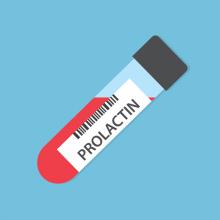Prolactin and Hair Loss

As I always say, reversing alopecia is an inside job. And it’s multifactorial—there’s a stacking of triggering factors and it’s never one thing.
But don’t let that overwhelm you because many of the “things” are interrelated. In other words, you don’t have to think of managing your triggers/root causes as silos.
As I also love to say, “We’re going to be catching a lot of butterflies with one net.”
If we take a bird’s eye view, two big considerations in reversing alopecia are modulating the immune system and balancing hormones. There are various spokes on these wheels, including some follicle-specific considerations, but these are the broad areas that we address with all of my clients and Reversing Alopecia course participants.
And yes, there’s interplay between the immune system and our endocrine (hormonal) system.
The hormones that are most commonly associated with hair loss are the androgens (DHEA, testosterone, and DHT) and thyroid (hypothyroidism). There are others that are equally important, like cortisol, and another is prolactin, which rarely gets the attention it deserves.
Not Simply a Women’s Hormone
Prolactin is secreted by the pituitary gland and is referred to as “the breastfeeding hormone” because its primary role is to stimulate milk production (lactation). During the initial months after delivery, it inhibits ovulation to prevent another pregnancy.
But you don’t have to be breastfeeding to have elevated prolactin—nor do you need to be female.
If it’s is elevated (hyperprolactinemia), shedding can be an ongoing issue for either sex.
This study showed that “human anagen scalp HFs (hair follicles) are very sensitive for inhibitory PRL-R-mediated (prototypic pituitary hormone prolactinreceptor) signals.”
Not Simply Associated with Diffuse Loss
While it’s largely associated with the androgenic alopecia pattern, we’ve worked with clients with patchy loss who indeed, have had hyperprolactinemia.
Although it can have an inhibitory effect on some hormones, like estrogen, progesterone, LH (luteinizing hormone), and FSH (follicle stimulating hormone), for some, it can lead to androgen excess, which can also be an issue for those with patchy alopecia.
In fact, for women, elevated prolactin can be mistaken for PCOS (polycystic ovary syndrome), which is often characterized by high androgens. The androgenic alopecia pattern is very common in the PCOS community—and while PCOS is often diagnosed due to a “collection of symptoms” (including dysglycemia/insulin resistance, infertility, hirsutism (excessive hair growth on the upper lip, chin, chest, or back), acne, heavy cycles, or no cycles at all), for many, the tip-off is the androgenic alopecia pattern.
If not breastfeeding, hyperprolactinemia can be a result of:
- Hypothyroidism, by way of elevated TRH (thyrotropin-releasing hormone)
- Low dopamine
- Medication usage, including anti-depressants (SSRIs), high blood pressure meds, and opioids
- Elevated IGF-1 (insulin-like growth factor)
- Chronic anxiety (as cortisol can increase prolactin AND androgen synthesis)
- A prolactinoma, which is a noncancerous tumor of the pituitary gland
Signs and symptoms include:
- Infertility
- Low libido
- Hair loss
For women specifically:
- Changes in menstrual cycles unrelated to menopause, like irregularity or amenorrhea (no cycle)
- Vaginal dryness
For men specifically:
- Low testosterone
- Erectile dysfunction (ED)
- Enlarged breast tissue (gynecomastia)
I believe that prolactin should be part of any basic serum (blood) hormone panel. There are differing opinions on what the functional range should be, but generally:
For females: 3-10 ng/mL (although some experts claim that < 25 is normal)
For males: 2-10 ng/mL (although some experts claim that < 20 is normal)
How to Lower Prolactin
- Get plenty of sunlight, which has been shown to inhibit prolactin production
- Maintain healthy dopamine levels with adequate sleep, movement, prayer/meditation, a creative outlet, listening to your favorite music, and a whole foods diet, including plenty of tyrosine (which we get from protein) and dopamine-inducing foods like apples, beets, blue-green algae, celery, dairy (if tolerated), sweet peppers, watermelon, cucumber, dark leafy greens, and honey
- Manage your stressors
- Maintain a healthy thyroid
- Check your meds
- Consider getting tested for a prolactinoma
- Women, consider chaste tree/vitex. According to Dr. Lara Briden: “Vitex suppresses prolactin so strongly that it can mask the symptoms of a prolactinoma, so check with your doctor about high prolactin before trying natural treatment.” (Men, you can take vitex too, but please consult with your provider and also know that it can tank your libido.)
Please consider joining me in The Reversing Alopecia Roadmap year-long course, where I cover this…and so, so much more. Yes, it’s a year-long program with 22 modules of targeted support, LIVE coaching, guest interviews, and community support. I’d love to see you there.
Add comment